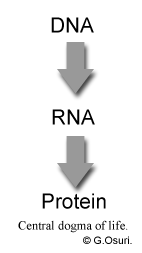



 |
 |
|
||||
 |
|
|
||||
 |
|
|||||
|
|
|
|
|
|
||
I.a. The DNA, RNA and ProteinsDNA or other wise called deoxyribonucleic acid is the building block of the life. It contains the information the cell requires to synthesize protein and to replicate itself, to be short it is the storage repository for the information that is required for any cell to function. Watson-Crick has discovered the current-structure of DNA in 1953.The famous double-helix structure of DNA has its own significance. There are basically four nucleotide bases, which make up the DNA. Adenine (A), Guanine (G), Thymine (T) and Cytosine(C). A DNA sequence looks some thing like this "ATTGCTGAAGGTGCGG". DNA is measured according to the number of base pairs it consists of, usually in kBp or mBp(Kilo/Mega base pairs). Each base has its complementary base, which means in the double helical structure of DNA, A will have T as its complimentary and similarly G will have C. nbsp; DNA molecules are incredibly long. If all the DNA bases of the human genome were typed as A, C, T and G, the 3 billion letters would fill 4,000 books of 500 pages each! The DNA is broken down into bits and is tightly wound into coils, which are called chromosomes; human beings have 23 pairs of chromosomes. These chromosomes are further broken down into smaller pieces of code called Genes. The 23 pairs of chromosomes consist of about 70,000 genes and every gene has its own function. As I have mentioned earlier, DNA is made up of four nucleotide bases, finding out the arrangement of the bases is called DNA sequencing, there are various methods for sequencing a DNA, it is usually carried out by a machine or by running the DNA sample over a gel otherwise called gel electrophoresis. A typical sequence would look like this "ATTTGCTGACCTG". Fig 1.1.1. Sample genetic code with complementary strands. Determining the gene's functionality and position of the gene in the chromosome is called gene mapping. Recent developments show that scientists are mapping every gene in the human body. They named their project Human Genome Project (HGP), which involves careful study of all the 70,000 genes in human body. Whew! That's some thing unimaginable. When there is a change in the genetic code it is called mutation. The significance of a DNA is very high. The gene's sequence is like language that instructs cell to manufacture a particular protein. An intermediate language, encoded in the sequence of Ribonucleic Acid (RNA), translates a gene's message into a protein's amino acid sequence. It is the protein that determines the trait. This is called central dogma of life.  Fig 1.a.2 Central dogma of life. Notes: Genes are DNA sequences instruct cells to produce particular proteins, which in turn determine traits. Chromosomes are strings of genes. Mutations are changes in gene's DNA sequence. RNA is somewhat similar to DNA; they both are nucleic acids of nitrogen-containing bases joined by sugar-phosphate backbone. How ever structural and functional differences distinguish RNA from DNA. Structurally, RNA is a single-stranded where as DNA is double stranded. DNA has Thymine, where as RNA has Uracil. RNA nucleotides include sugar ribose, rather than the Deoxyribose that is part of DNA. Functionally, DNA maintains the protein-encoding information, whereas RNA uses the information to enable the cell to synthesize the particular protein.
|
© G.Osuri, 2003. This is an information tutorial and can be freely distributed along with permission. email: g_osuri@hotmail.com